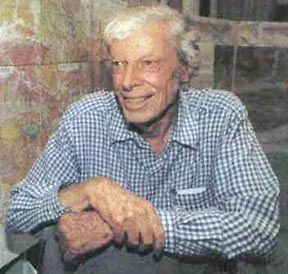 |
| Photo of Thomas W. Dibblee from the Thomas Dibblee Foundation Web Site |
My hero is my friend. Thomas Wilson Dibblee, Jr., an elderly geologist of worldwide fame, was born 91 years ago and has lived all his life right here in Santa Barbara, California. He spent his boyhood on a cattle ranch that was granted to his ancestors by the King of Spain before California became a part of the United States. He fell in love with rocks and land forms (that is geology) when, as a child, he followed an experienced geologist around the family ranch looking for signs of oil or water.
 |
| All areas in this map of California that are marked in RED were mapped by Thomas Dibblee. |
Later, he went to Stanford University where he studied to become a geologist. He then went to work for Richfield Oil Company in California, and they recognized his ability as a geological field man. This was a man who could drive, ride horseback or walk across hills and map what kind of rocks were under the soil, determine which way they were slanting and what kind of fossils were in them. His work resulted in the geological maps that Richfield used to decide where to drill wildcat wells to see if there was an oil field. Sure enough, one of their wildcats discovered the Cuyama Oil Field, and they named the oil zone the Dibblee Formation.
Tom became famous for his low-cost field work. Legend has it that he would buy a crate of lettuce, a couple loaves of bread, and a jar of peanut butter and disappear into the hills for a week at a time, sleeping in his car.
When he retired from Richfield, he went to work for the United States Geological Survey doing the same thing he did for Richfield. He wasn't through with geology. He wasn't looking for oil, but simply mapping the rocks on government topographic quadrangle maps, mainly on national forest lands. These were published so anyone could buy one. They were useful for farmers, foresters, students, hikers, government agencies, and other geologists. He did this so well that the president of the United States presented him with a medal upon his second retirement.
 |
| Thomas Dibblee, legendary geologic mapper, digitizes his maps. July 2001 Susan Baum |
About that time (1983), a group of his fellow geologists in Santa Barbara got together and decided to form a geological society in his honor. They named it the Thomas W. Dibblee Geological Foundation. Its purpose was to publish, in color, all of Tom's unpublished maps and make them available to all at a very reasonable price. This small informal nonprofit corporation had already published over 80 of these colorful maps, mostly in Southern California, more quickly, more beautifully and cheaper than the government could. Right now, the foundation is in the process of merging with the Santa Barbara Museum of Natural History to guarantee its future service to the people of California.
Tom is my hero because he continued throughout his life the pursuit of his boyhood dream: to continue studying the earth with all his mind, all his heart, and all his time. Fortunately, he chose an occupation that not only satisfied him, but provided a service to thousands of his fellow citizens. He is one of a kind.
Page created on 10/4/2004 10:04:19 AM
Last edited 1/9/2017 11:13:21 PM
